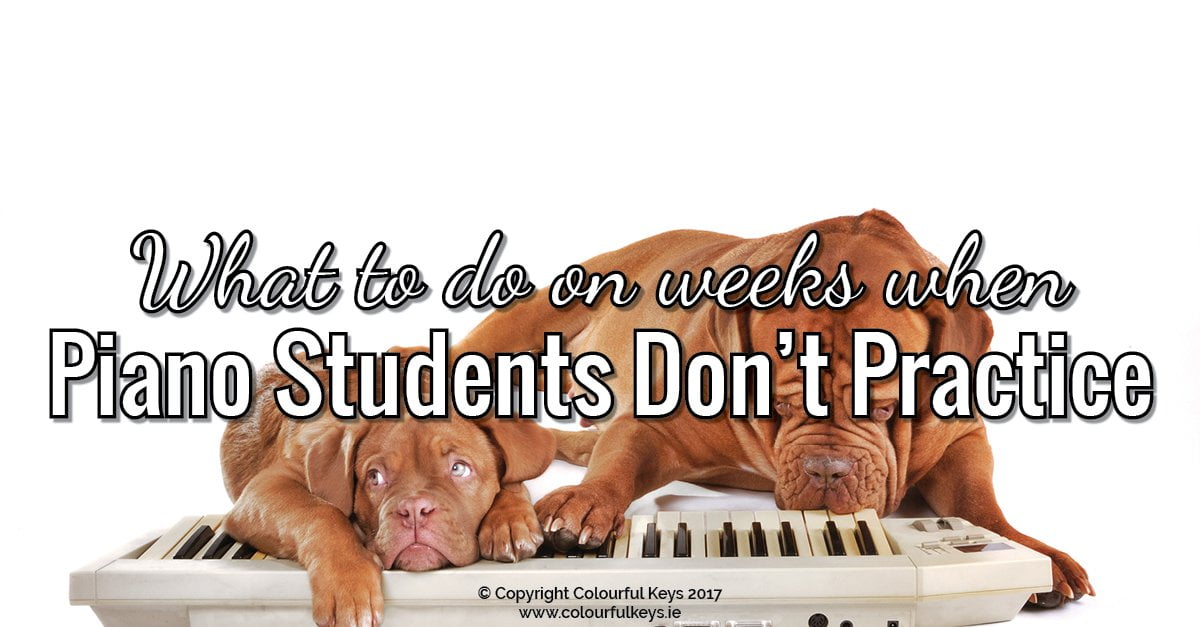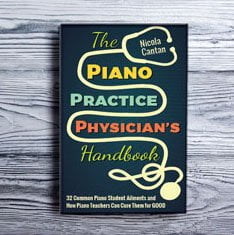There are certain times of the year when practice is likely to be lagging. This is especially common just after a recital – and/or just before a teaching break.

So, what can you do in these no practice piano lessons? Are you just going to tell your student that they should practice, and review all the same things you did last week…essentially creating a piano lesson groundhog day?
This usually won’t create the desired effect. Although you may feel frustrated – these ebbs and flows of practice are part and parcel of your piano student’s journey.
The way to overcome or work through the valley of piano practice is not to tell your student to practice. It’s to inspire her to practice.
These 8 activities are my go-tos when a student hasn’t practiced. Use them in your own studio to make no practice lessons fun and motivating – not dry and disheartening – for you and your students.
This post contains some affiliate links. Buying from one of these links does not cost you anything, but I do receive a small referral fee for sending you which goes towards the cost of running this site.
1. Improvisation
Music doesn’t have to be prepared in advance, and it doesn’t have to be read off a page. It can be created in the moment for the pure joy of it.
Including improvisation in your lessons will make your students better listeners, more musical and can even give them a greater appreciation of scales and music theory.
If you haven’t tried much improvisation in your lessons you might be nervous to get started. I totally get that, and I’ve been there.
The best resource I know for improvisation newbies is Create First by Forrest Kinney. These are duets (solo books are also available) that the teacher can play as the student explores the keys. They sound wonderfully rich and are super simple and straight-forward to dive into. Give it a go!
2. Games Galore
If you know me at all, this one won’t be a surprise. 😉
Music theory games are my top choice to fill any spare time in my lessons because they improve learning retention, help students progress faster, and are just downright FUN.
If you’ve been thinking about including more gamified music theory in your teaching for a while – but just don’t know how to make it effective – then you need to go take a look at the Vibrant Music Teaching library.
This is the resource that I created because I couldn’t find anything remotely like it. It’s organised and sortable by theory concepts, numbers of students, and student levels. Using the VMT library you can actually find and use games to teach your students effectively, not just for the sake of it.
3. Jazzing Up an Old Piece
Another great use of this no practice lesson time is to revisit an old piece. Take any piece your student previously mastered and loved playing. It could be something from a few weeks ago or a year ago, doesn’t matter.
When you’ve chosen your piece, have some fun with it:
- Add ornaments and embellishments
- Change the left hand patterns and play with the harmonies
- Create a lead sheet version
- Insert an improvised section in the middle
- Play with the dynamics and expression to create new versions
This activity is not only fun and engaging, but your student can learn about so much music theory.
Things like ornaments and harmonies make so much more sense when they’re experienced and applied than when they’re read and deciphered.
4. Practice Strategies
What better way to use lesson time hampered by a lack of practice, than to teach your student some great practice techniques?
If done right, this has two benefits:
- Your student will learn to make her practice more efficient.
- Your student will learn that practice can be fun!
In need of some great practice strategies? Try these practice step stickers, make some practice kits, or read my book about practice which you can find on Amazon here.
5. Sight Reading
Sight reading doesn’t have to mean dry, boring and unmusical exercises. All sight reading really is is reading after all. That is, reading music you haven’t seen before.
The next time you run into a no practice situation, bring out any book that is a few levels below where your student is at. Try to pick something that is in a style they’ll love too – whatever that is for your student.
If possible – go for a duet book. Sight reading duets is more fun and also better practice than solo repertoire since she won’t be able to backtrack, slow down or speed up. (You’ll make sure of that!)
I discussed these first five ideas in this Facebook live a couple of weeks ago.
Keep reading for three more ideas that I didn’t mention in that video. 🙂
6. Learn a Piece by Ear
Has your student been hankering after a pop song? Take advantage of this no practice lesson to work it out together!
This exercise will teach your student tons about the way chords function in pop music, repeating patterns and will help her hone in on her aural skills. Much more valuable than trying to decode a crazy transcription in some bizarre time signature.
7. Dance
What, huh, why now? How come we’re dancing in our piano studios?
Many of the classical pieces our students will learn are actually dance forms. These will make so much more sense if you dance them first.

If your student is learning any dances, or you know they will be soon – stick on a recording and teach her some steps. It might look a little zaney (and you might get some raised eyebrows when parents arrive for pick-up!) but it’s a totally valid use of your time in my opinion.
I promise your student won’t magically turn her next triple metre piece into quadruple when she has actually danced a waltz.
8. Compose
A final, very worthwhile option for your no practice lesson is to compose a piece of music together.
This might take up the entire lesson time, but your student will learn a heap.
- Start the process with any topic or starting point that interests her.
- Then take a chord progression, scale or pentascale that she knows and use it as a framework for the new piece.
- Make sure to have your student notate the composition herself for maximum effect.
You may just find she actually practices the following week when the piece is her own creation.
What do you do in no practice piano lessons?
Do you review the assignments? Repeat last week’s lesson? Have some fun like me?
Tell me your ideas, thoughts and musings in the comments below or in the Vibrant Music Studio Teachers community on Facebook.


